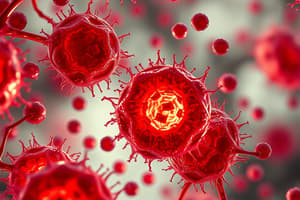Podcast
Questions and Answers
What can be seen in the lower part of the image?
What can be seen in the lower part of the image?
- Simple columnar epithelium
- Goblet cells
- Intercalated discs
- A coronary blood vessel (correct)
Where can you find the layer of simple columnar epithelium?
Where can you find the layer of simple columnar epithelium?
- At the intercalated discs
- In the coronary blood vessel
- On the surface of the cardiac muscle cells
- On the surface of the villi (correct)
What is the function of the goblet cells?
What is the function of the goblet cells?
- To form intercalated discs
- To supply the cardiac muscle with oxygen and nutrients
- To absorb nutrients from the digestive system
- To produce and release mucus (correct)
What can be seen as dark lines perpendicular to the axis of the cardiac muscle cells?
What can be seen as dark lines perpendicular to the axis of the cardiac muscle cells?
What should you do if you have trouble finding intercalated discs in lab?
What should you do if you have trouble finding intercalated discs in lab?
Why do the goblet cells appear clear in the image?
Why do the goblet cells appear clear in the image?
What is the primary characteristic of erythrocytes observed in the image?
What is the primary characteristic of erythrocytes observed in the image?
What is unique about the leukocyte on the left in the second image?
What is unique about the leukocyte on the left in the second image?
Why is the second image included?
Why is the second image included?
What is characteristic of the leukocytes in the image?
What is characteristic of the leukocytes in the image?
What is difficult to see in the image?
What is difficult to see in the image?
What is a characteristic of some leukocytes in the image?
What is a characteristic of some leukocytes in the image?
Flashcards are hidden until you start studying




